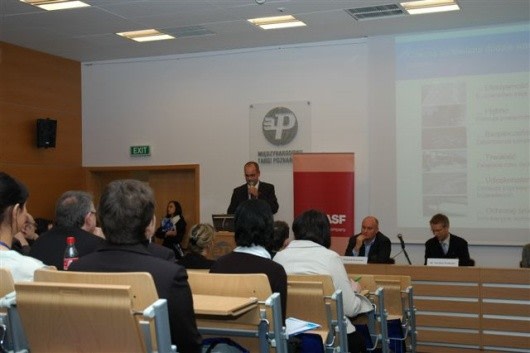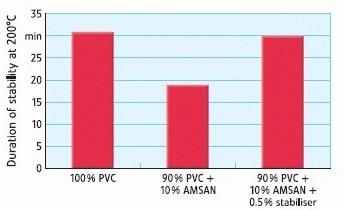Thus, the addition of 5 % by weight of an acrylate-based impact resistance modifier to a (PVC+AMSAN) blend (85:15 % by weight) is sufficient to achieve impact resistance values which were above those of the unmodified PVC used for producing the AMSAN blends (23.8 instead of 16 kJ/m2). As expected raising the proportion of modifier further increases the impact resistance levels and in all the blends studied the elongation at break values were also at a higher level.

Adapting Thermal Stability by Means of Stabilisers
On the other hand, the restoration of the thermal stability of (PVC+AMSAN) blends requires more detailed consideration of the degradation processes. The cause of the gradual decomposition of polyvinyl chloride at relatively high temperatures is the elimination of hydrogen chloride, which once started proceeds in accelerated fashion due to autocatalysis.Initially this gives rise only to local discoloration of the plastic, but later adversely affects the mechanical properties of the entire product. A number of routes are available for stabilising PVC against this degradation process. Thus, the progress of the reaction can be slowed down by capturing the hydrogen chloride by means of suitable basic additives or by converting the first intermediate of the decomposition process - reactive allyl chloride - into products which pose no threat.
To this end the PVC processor can draw on a large number of tried and tested additives having correspondingly varied action mechanisms.
In order to test whether established additives are also suitable for retarding the accelerated degradation reaction in the presence of nitrite-containing polymers, trials were carried out on (PVC+ABS) blends at the Süddeutsches Kunststoff- Zentrum. Not only were the stabilizers which come into consideration studied, but also the quantities in which they need to be added. The stability of each blend was evaluated in a stream of nitrogen heated to 200°C (DIN 53381-1, test B). Even small quantities of a suitable stabilizer are capable of effectively retarding the thermal degradation of (PVC+ABS) blends.
These results are naturally transferable to (PVC+AMSAN) blends. In a direct trial the addition of 0.5 % by weight of this stabiliser was sufficient to raise the thermal stability of a mixture of polyvinyl chloride and an a-methylstyrene-acrylonitrile copolymer (90:10 % by weight; total nitrile content: about 3 %) to the level of the pure PVC.

Given a corresponding level of addition, (PVC+AMSAN) blends exhibit levels of impact resistance and thermal stability equivalent to those of pure polyvinyl chloride.
This should have great potential in applications which hitherto could not be fulfilled at all or could be fulfilled only inadequately because of the low heat resistance of PVC and on grounds of cost.
Specifically in the building sector great prospects are now opening up for the blend. In this field there will no doubt be news in future about some remarkable solutions.



